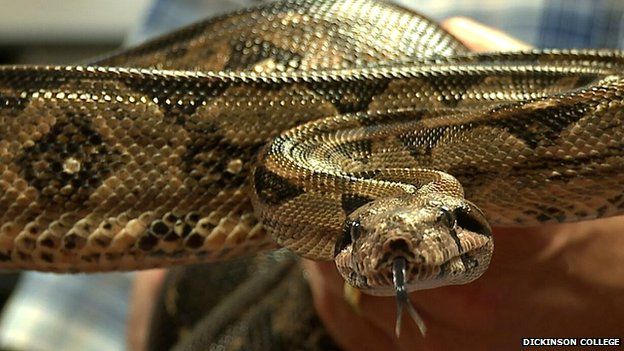Boa constrictors' lethal secret revealed
- Published

Scientists in the US have measured how boa constrictors end the lives of their prey.
The work has busted a myth that the snakes suffocate their victims.
Researchers took measurements - including blood pressure and heart activity - from anaesthetised rats gripped by the snakes.
This showed that the lethal grip restricted blood flow severely enough to cut off the blood flow supplying oxygen to its vital organs.
The findings are published in the Journal of Experimental Biology.
This "circulatory arrest", the scientists say, is a much more efficient, rapid and definite way of finishing off prey than expected.
As the lead researcher, Prof Scott Boback, from Dickinson College in Pennsylvania, explained, restricting blood flow to the brain would also make a rodent "pass out within seconds".
The researchers believe that recording during a constriction could reveal useful details about how crush injuries cause complex tissue damage in humans.
But Prof Boback and his team are interested primarily in the fundamental question of how and why these snakes evolved their unique killing method.
"The thing I find fascinating is that all snakes have is their mouth to engage with prey," said Prof Boback.
"A [constrictor] has to hold a potentially dangerous animal right next to it.
"And that animal's fighting for its life, so it will absolutely take chunks out the snake if it can."
He and his colleagues realised that, in order to measure this life-or-death battle, they would need to record the very point of death of the prey.
Death grip
They presented anaesthetised, unconscious lab rats to boa constrictors, and recorded from the rats' arteries and heart as they were squeezed.
The scientists also took blood samples before and after, revealing how the blood chemistry of a constricted victim changed.
From this, they concluded that the constriction "shuts off" blood flow and oxygen supply to the organs.
And this lack of oxygen, or ischaemia, rapidly destroys the tissue of the oxygen-hungry brain, heart and liver.
"If the snake is wrapping around the chest, it could also be limiting breathing, too," said Dr Boback.
"But an absence of blood flow will cause death more rapidly than suffocation.
"So it could be considered a much more precise and efficient method of killing."
This study is the first to test for this circulatory arrest directly - measuring from the body of the snake's prey.
Prof Brad Moon, from the University of Louisiana at Lafayette, has studied snake movements, including constriction, for two decades.
He said the study showed constrictors could "squeeze prey hard enough" to interfere with blood pressures, blood gases, blood chemistry, and even heart function.
"It isn't the first test of circulatory arrest from constriction," Prof Moon told BBC News, "but it is the first direct test that measured blood pressures and [heart activity].
"It shows that constriction is stronger, faster and more effective than expected."
In a previous study, the same Dickinson College team discovered that the snakes were able to sense their victim's heartbeat, and stopped squeezing only when it stopped.
- Published9 January 2015
- Published18 January 2012
- Published2 July 2010